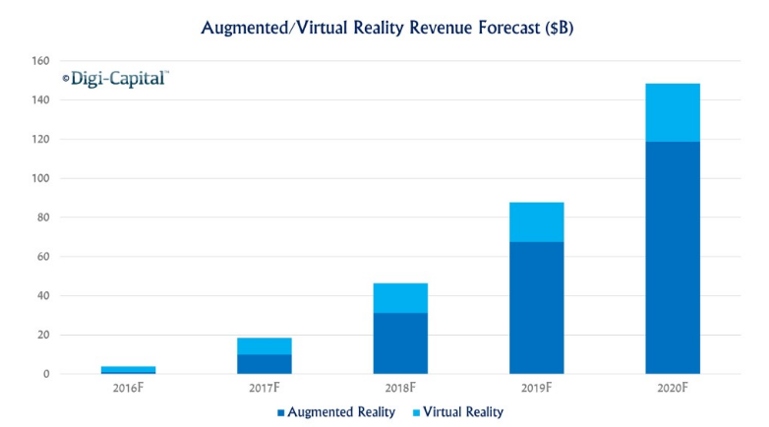In recent years, the growing popularity of VR products like VIVE and Oculus Rift has fueled the expansion of the VR market. At the same time, the rapid adoption of AR games last year and the widespread use of AR-based red envelopes during the Spring Festival this year have sparked significant interest in the AR market. As a result, VR and AR have gradually become part of everyday life. According to Digi-Capital, by 2020, the global VR and AR market is expected to reach $150 billion. IDC also reported that China's VR market experienced explosive growth of 441.2% in 2017. Among the mainstream VR formats, all-in-one headsets and head-mounted displays are currently receiving a lot of attention. Meanwhile, Google has been working to transform smartphones—devices with the largest user base—into mobile VR devices. The rise of mobile VR could truly accelerate the development of the entire VR industry.



Figure 1: Digi-Capital predicts global VR and AR market size
Google is building a VR/AR ecosystem through its "dual platform" strategy, with high-performance sensors playing a key role. These sensors also need to be verified for compatibility with the Daydream and Tango platforms. InvenSense, a leading provider of MEMS sensors, has been at the forefront of this development. The Daydream team mentioned in an interview that Daydream has set higher hardware standards for Android 7.x HiFi, and most current phones do not meet these requirements. Motion sensors, as essential components in smartphones and head-mounted devices, must also pass verification from Daydream and Tango to meet the Android 7.x HiFi specifications. Among them, InvenSense sensors have emerged as a top choice. InvenSense’s high-performance sensors have become the preferred option for VR/AR equipment. As one of the world’s leading MEMS sensors providers, InvenSense achieved outstanding performance on the Daydream and Tango platforms as early as summer 2016. The ICM-20600 and ICM-20602 models were verified by Daydream, while the ICM-20690, launched at the end of 2016, made a major breakthrough in VR/AR user experience due to its dual verification on both platforms. Key performance metrics such as temperature stability, anti-shake effect, sensitivity, sensitivity error, offset temperature drift, and sensitivity temperature drift have all shown excellent results. “Providing better VR and AR experiences to end users has always been our goal,†said Nicolas Sauvage, Senior Ecosystem Director at InvenSense. “Working closely with the Daydream and Tango teams allows us to focus on key technology nodes and deliver the best experience for users. We also provide technical support for customers using Daydream and Tango products.†Beyond hardware performance, InvenSense’s unique algorithms ensure mass production and a seamless user experience. For example: - **1K Sensor Fusion**: Achieving a 1 kHz update rate on standard MCUs to provide accurate attitude calculations with less than 10 PPM time error. - **In-Run Calibration**: Real-time multi-sensor calibration that is more accurate than factory calibration, using simple movements of normal VR headsets. - **Predictive Quaternion**: Enhancing back-end rendering by predicting attitude estimation, reducing GPU bandwidth and smoothing the visual experience.
Figure 2: InvenSense 3 sensors verified with Daydream and Tango dual platforms
Today, many leading VR and AR devices, including Facebook’s Oculus Rift, HTC Vive, Microsoft HoloLens, and various domestic VR/AR manufacturers, use InvenSense sensors. Whether it’s the superior performance, cost-effectiveness, or advanced software algorithms, InvenSense’s sensing hardware has become the go-to choice for VR and AR devices. Continuing innovation drives the ICM-20690 series sensors, which keep pushing smart devices forward. High-performance sensors have become essential in mobile smart devices, and innovation remains a central theme for sensor platform providers. InvenSense’s OIS+UI dual-channel application for 6-axis MEMS sensors has not only helped popularize high-end flagships but has also been "double-verified," making it a key component in the first commercial devices of the Google Daydream and Tango platforms. This will continue to drive upgrades across a wide range of smart devices.Portable Battery Digital Signage
Portable Battery Digital Signage,Portable Sign Board,Sign Board,Portable Digital Signage
Shenzhen Risingstar Outdoor High Light LCD Co., Ltd , https://www.risingstarlcd.com